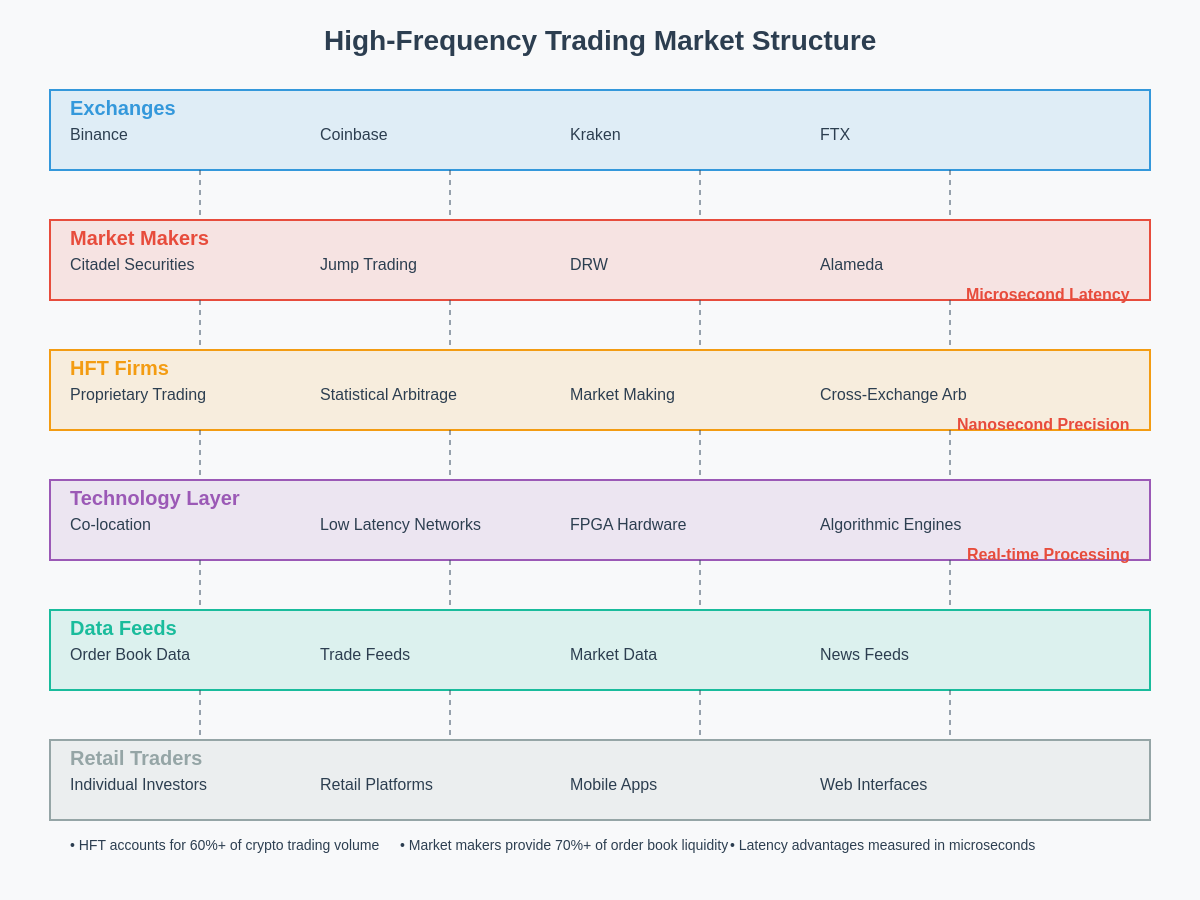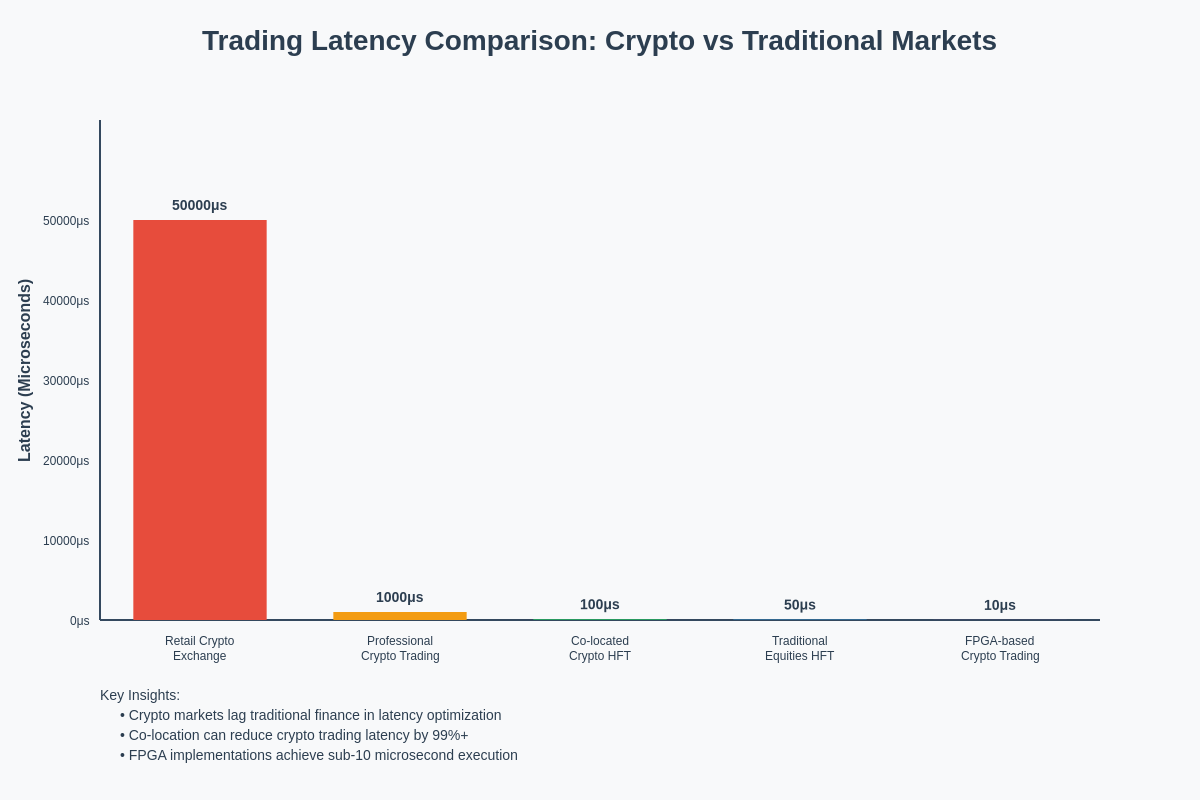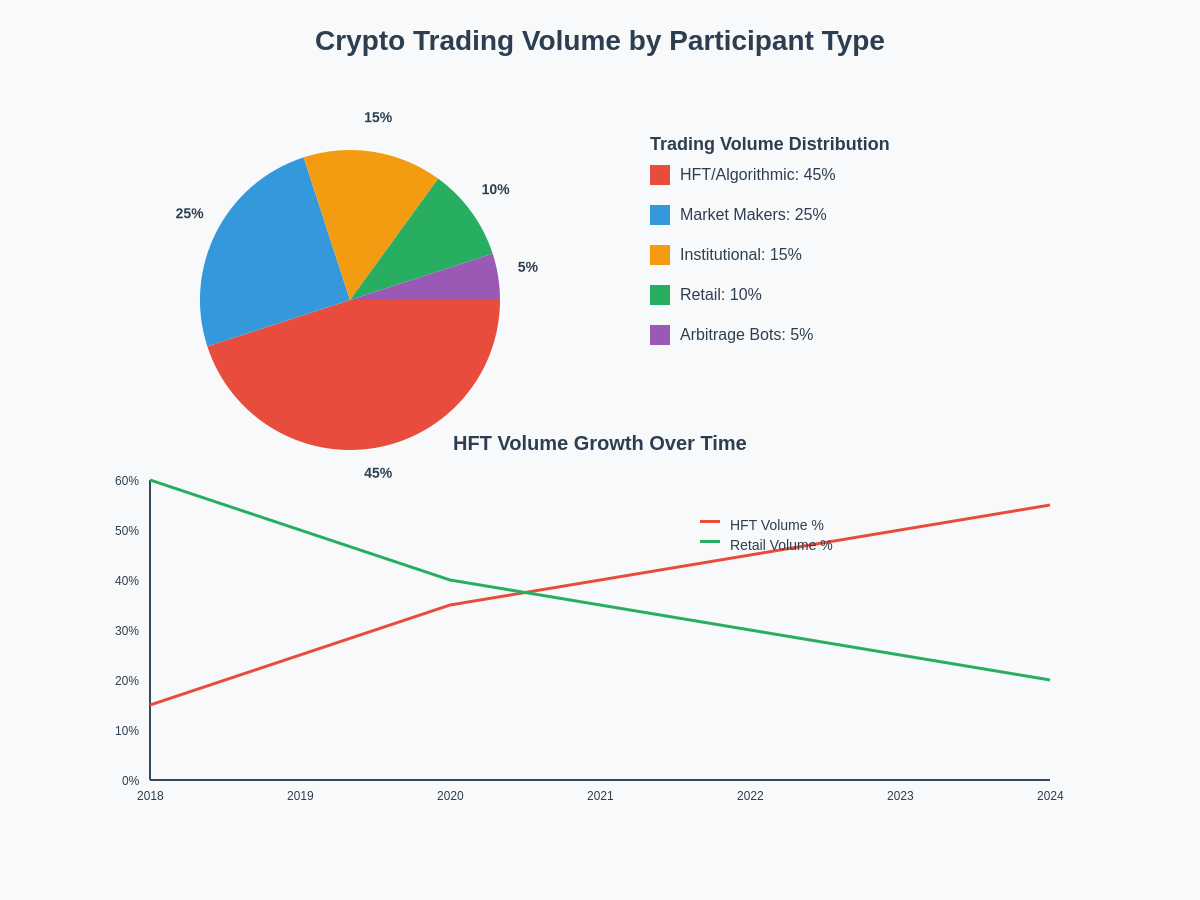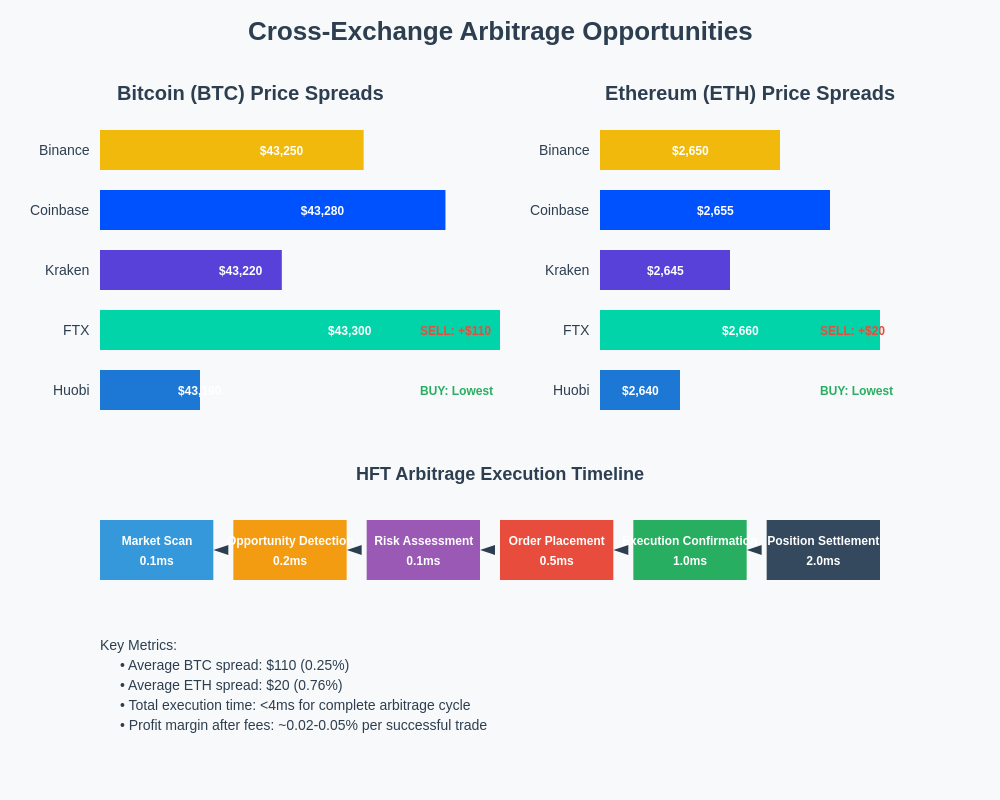Advanced trading analytics and Pine Script resources offer comprehensive tools for analyzing high-frequency trading patterns in cryptocurrency markets.
The Rise of Algorithmic Dominance in Cryptocurrency Markets
High-frequency trading has fundamentally transformed the structure and dynamics of cryptocurrency markets, bringing both enhanced liquidity and increased complexity to digital asset exchanges. The proliferation of sophisticated algorithmic trading strategies has created a multi-tiered market structure where microsecond advantages translate into significant competitive benefits, fundamentally altering how price discovery occurs and how market participants interact within the cryptocurrency ecosystem.

The emergence of professional trading firms specializing in cryptocurrency markets has introduced institutional-grade technology and strategies previously exclusive to traditional financial markets. These organizations deploy advanced algorithms capable of processing market data and executing trades at speeds measured in microseconds, creating a technological arms race that has reshaped the competitive landscape of cryptocurrency trading.
Market microstructure analysis reveals that high-frequency trading now accounts for a significant portion of trading volume across major cryptocurrency exchanges, with some platforms reporting that algorithmic trading comprises more than sixty percent of total transaction volume during peak trading periods. Professional traders utilizing advanced charting platforms can analyze these market dynamics and develop strategies to navigate the increasingly algorithmic trading environment. This concentration of automated trading activity has profound implications for market efficiency, price stability, and the trading experience of retail investors who lack access to similar technological capabilities.
The sophistication of modern cryptocurrency trading algorithms extends beyond simple arbitrage strategies to encompass complex market-making operations, statistical arbitrage, momentum trading, and cross-exchange coordination that leverages the fragmented nature of cryptocurrency markets. These strategies operate across multiple exchanges simultaneously, exploiting price differentials and market inefficiencies that exist due to the decentralized and often uncoordinated nature of cryptocurrency trading infrastructure.
Market Making and Liquidity Provision Mechanisms
Professional market makers have become essential participants in cryptocurrency markets, providing continuous bid and offer quotes that enable efficient price discovery and reduce transaction costs for other market participants. These sophisticated algorithms continuously adjust their quotes based on market conditions, order flow analysis, and risk management parameters, creating a dynamic pricing environment that responds rapidly to changes in supply and demand.
The role of market makers in cryptocurrency markets differs significantly from traditional financial markets due to the twenty-four-hour trading environment, higher volatility, and fragmented exchange landscape that characterizes digital asset trading. Market makers often rely on real-time market data and analysis tools to monitor cross-exchange spreads and identify optimal positioning opportunities. Market makers must deploy capital across multiple exchanges simultaneously while managing inventory risk, adverse selection risk, and the technical challenges associated with maintaining reliable connectivity to numerous trading platforms.
Advanced market making strategies employ machine learning algorithms that analyze historical trading patterns, order book dynamics, and cross-exchange relationships to optimize quote placement and inventory management. These systems continuously adapt their parameters based on changing market conditions, enabling them to maintain profitability while providing valuable liquidity services to the broader market.
The compensation structure for market making in cryptocurrency markets typically involves rebate programs offered by exchanges to incentivize liquidity provision, creating a business model where market makers profit from the spread between bid and offer prices plus exchange rebates for providing liquidity. This structure has led to intense competition among market makers, driving down spreads and improving market efficiency while creating challenges for less sophisticated participants.
Technical infrastructure requirements for competitive market making include co-location services, ultra-low latency connectivity, sophisticated risk management systems, and redundant failover mechanisms to ensure continuous operation in the volatile cryptocurrency market environment. The capital requirements and technological complexity have created significant barriers to entry for smaller participants while enabling well-funded professional firms to dominate liquidity provision.

Arbitrage Strategies and Cross-Exchange Coordination
The fragmented nature of cryptocurrency markets creates numerous arbitrage opportunities that high-frequency trading firms exploit through sophisticated cross-exchange strategies. These opportunities arise from price differentials between exchanges, temporary imbalances in supply and demand, and inefficiencies in how different platforms handle order matching and execution.
Spatial arbitrage involves identifying and exploiting price differences for the same cryptocurrency across different exchanges, requiring rapid execution capabilities and efficient capital deployment to capture profits before market forces eliminate the price differential. Many professional arbitrage traders utilize comprehensive market monitoring tools to track price differentials across multiple exchanges in real-time. Successful spatial arbitrage operations require real-time monitoring of order books across multiple exchanges, rapid order routing capabilities, and sophisticated risk management to handle execution risks and exchange-specific operational challenges.
Temporal arbitrage strategies exploit predictable patterns in cryptocurrency price movements, such as those associated with regular events like futures contract expirations, options settlements, or scheduled network upgrades that affect specific cryptocurrencies. These strategies require extensive historical data analysis and sophisticated prediction models to identify profitable trading opportunities while managing the risks associated with unexpected market movements.
Triangular arbitrage opportunities arise when the implied exchange rates between different cryptocurrency pairs create profit opportunities through a series of rapid trades. For example, if the Bitcoin to Ethereum exchange rate differs from the product of Bitcoin to USD and USD to Ethereum rates, sophisticated algorithms can identify and exploit these discrepancies through coordinated trading across multiple pairs.
Cross-exchange coordination strategies involve simultaneously placing orders on multiple exchanges to optimize execution quality, reduce market impact, and capture arbitrage opportunities that span multiple trading venues. These strategies require sophisticated order management systems capable of handling the technical complexities of interfacing with different exchange APIs while managing the risks associated with partial fills and execution failures.

Technology Infrastructure and Latency Optimization
The technological infrastructure supporting high-frequency cryptocurrency trading represents a significant investment in hardware, software, and connectivity solutions designed to minimize latency and maximize system reliability. Professional trading firms typically deploy their systems in close physical proximity to exchange servers through co-location arrangements that reduce network latency to microsecond levels.
Network optimization strategies include dedicated fiber optic connections, microwave transmission systems, and strategic placement of trading servers to minimize the physical distance between trading algorithms and exchange matching engines. The speed of light becomes a practical constraint in high-frequency trading, making geographic proximity to exchange infrastructure a critical competitive advantage.
Hardware optimization involves specialized computer systems designed for low-latency operation, including custom network interface cards, high-performance processors optimized for specific computational tasks, and memory architectures that minimize data access times. These systems often employ field-programmable gate arrays and other specialized hardware to achieve execution speeds that would be impossible with standard computer architectures.
Software architecture for high-frequency trading systems emphasizes deterministic performance, minimal garbage collection, and direct hardware access to achieve consistent low-latency operation. These systems typically bypass operating system layers that could introduce unpredictable delays, employing kernel bypass networking and direct memory access techniques to maintain stable performance under high-throughput conditions.
Monitoring and risk management systems must operate at the same speed as trading algorithms to provide real-time oversight of trading activities, position limits, and system health. These systems employ sophisticated alerting mechanisms and automated circuit breakers designed to halt trading activities if predetermined risk thresholds are exceeded or if system anomalies are detected.
Impact on Price Discovery and Market Efficiency
High-frequency trading has significantly enhanced the speed and efficiency of price discovery in cryptocurrency markets by rapidly incorporating new information into asset prices and reducing the persistence of arbitrage opportunities. The continuous presence of algorithmic trading strategies creates a more responsive market environment where prices adjust quickly to changes in fundamental value or market sentiment.
Research on cryptocurrency market efficiency suggests that the presence of high-frequency trading has reduced various forms of market inefficiency, including cross-exchange arbitrage opportunities, predictable intraday patterns, and the persistence of price anomalies that previously could be exploited by less sophisticated traders. This improvement in market efficiency benefits all market participants by reducing transaction costs and improving the quality of price discovery.
The relationship between high-frequency trading and market volatility remains complex and context-dependent, with some studies suggesting that algorithmic trading can amplify short-term volatility while others indicate that it provides stabilizing liquidity during periods of market stress. The net effect appears to depend on market conditions, the specific strategies employed by algorithmic traders, and the overall composition of market participants.
Price impact studies indicate that high-frequency trading strategies have generally reduced the market impact of large orders by providing additional liquidity and improving the efficiency of order execution. However, this benefit may not extend to all market participants equally, with some evidence suggesting that algorithmic traders may increase adverse selection costs for traditional investors who lack access to similar technology and information advantages.
The presence of sophisticated trading algorithms has also influenced the behavior of other market participants, leading to the development of execution algorithms designed to minimize information leakage and reduce transaction costs when trading in environments dominated by high-frequency strategies. This evolution has created a more complex market ecosystem where successful trading increasingly requires technological sophistication and strategic awareness of algorithmic trading dynamics.

Regulatory Challenges and Market Structure Evolution
The rapid growth of high-frequency trading in cryptocurrency markets has presented significant challenges for regulators seeking to maintain fair and orderly markets while preserving the benefits of technological innovation. Traditional regulatory frameworks developed for conventional securities markets may not adequately address the unique characteristics of cryptocurrency trading, including the global nature of digital asset markets, the diversity of trading platforms, and the technical complexity of modern trading algorithms.
Market structure regulations in traditional financial markets typically address issues such as market maker obligations, order handling requirements, and fair access to market data and execution facilities. Applying similar principles to cryptocurrency markets requires careful consideration of the decentralized nature of many digital assets, the international scope of trading activities, and the technical challenges associated with monitoring and regulating algorithmic trading strategies.
Surveillance and monitoring capabilities must evolve to keep pace with the sophistication of high-frequency trading strategies, requiring regulators to develop advanced analytical tools capable of detecting market manipulation, insider trading, and other abusive practices in high-speed trading environments. The pseudonymous nature of many cryptocurrency transactions adds additional complexity to regulatory oversight efforts.
International coordination becomes particularly important in cryptocurrency markets due to the global nature of digital asset trading and the ease with which trading activities can migrate between jurisdictions with different regulatory requirements. Regulatory arbitrage opportunities may incentivize trading firms to locate their operations in jurisdictions with more favorable regulatory environments, potentially undermining the effectiveness of national regulatory efforts.
The development of regulatory technology solutions specifically designed for cryptocurrency markets represents an emerging area of innovation, with various firms developing specialized tools for trade surveillance, market monitoring, and compliance management in digital asset markets. These solutions must address the unique technical and operational characteristics of cryptocurrency trading while providing the monitoring capabilities required by regulatory authorities.
Retail Investor Implications and Market Access
The dominance of high-frequency trading in cryptocurrency markets has created a multi-tiered trading environment where retail investors face significant disadvantages in terms of execution speed, information access, and technological capabilities. While retail investors benefit from improved market liquidity and tighter spreads resulting from professional market making activities, they may also face increased adverse selection when trading against sophisticated algorithmic strategies.
Order routing and execution quality have become critical considerations for retail investors seeking to optimize their trading outcomes in markets dominated by high-frequency strategies. Many cryptocurrency exchanges now offer advanced order types and execution algorithms designed to help retail investors minimize market impact and improve execution quality, though these tools may not fully level the playing field with professional trading firms.
Information asymmetries between retail and professional traders have evolved beyond traditional concepts of fundamental analysis to include technological capabilities, market microstructure knowledge, and access to sophisticated trading infrastructure. Professional traders may possess superior ability to analyze order flow patterns, predict short-term price movements, and execute complex multi-exchange strategies that are beyond the reach of individual investors.
Educational resources and tools designed to help retail investors understand and navigate high-frequency trading environments have become increasingly important for maintaining broad participation in cryptocurrency markets. These resources cover topics such as order types, market timing strategies, and the implications of algorithmic trading for individual investment decisions.
The development of retail-focused trading platforms that aggregate liquidity from multiple sources and employ smart order routing algorithms represents one approach to helping individual investors access improved execution quality in markets dominated by high-frequency trading. These platforms aim to provide institutional-quality execution capabilities to retail investors while maintaining user-friendly interfaces and reasonable fee structures.
Economic Models and Profitability Analysis
The economics of high-frequency trading in cryptocurrency markets involve complex trade-offs between technology investment, operational costs, market risks, and competitive dynamics that determine the profitability and sustainability of different trading strategies. Successful high-frequency trading operations require substantial upfront investment in technology infrastructure, ongoing operational expenses, and continuous reinvestment to maintain competitive advantages.
Revenue models for high-frequency trading typically combine profits from bid-ask spreads, exchange rebate programs, and alpha generation from sophisticated trading strategies. The relative importance of these revenue sources varies depending on market conditions, competitive dynamics, and the specific strategies employed by individual trading firms.
Cost structure analysis reveals that successful high-frequency trading operations face significant fixed costs related to technology infrastructure, data feeds, exchange connectivity, and personnel, while variable costs primarily relate to transaction fees, financing costs for inventory positions, and operational expenses. The high fixed cost structure creates economies of scale that favor larger, well-capitalized trading firms.
Competitive dynamics in high-frequency trading markets exhibit characteristics of winner-take-all competition, where small advantages in technology, strategy, or execution capability can translate into significant differences in profitability. This competitive pressure drives continuous innovation and investment while creating challenges for firms that fall behind in the technological arms race.
Risk management considerations include market risk from inventory positions, operational risk from system failures or connectivity issues, regulatory risk from changing compliance requirements, and competitive risk from the constant threat of strategy obsolescence. Many trading firms implement sophisticated risk management and monitoring systems to track portfolio exposure and system performance across multiple trading venues. Successful firms develop comprehensive risk management frameworks that address these diverse sources of risk while maintaining the operational flexibility required for profitable trading.
Market Making Economics and Exchange Relationships
The relationship between high-frequency market makers and cryptocurrency exchanges has evolved into a complex ecosystem of partnerships, incentive programs, and technological integration that shapes market structure and competitive dynamics. Exchanges compete for market maker participation by offering attractive rebate programs, advanced order types, and co-location services that enable optimal trading performance.
Market maker agreements often include volume commitments, uptime requirements, and spread maintenance obligations that ensure consistent liquidity provision in exchange for preferential fee structures and enhanced market access. These agreements create mutual dependencies where market makers rely on exchange infrastructure and incentives while exchanges depend on market makers for liquidity and trading volume.
The evaluation of exchange quality from a market maker perspective involves considerations such as matching engine performance, API reliability, order type availability, fee structures, and the overall competitive environment on each platform. Market makers must continuously assess the relative attractiveness of different exchanges and adjust their capital allocation accordingly.
Cross-exchange coordination strategies require market makers to manage relationships with multiple trading venues simultaneously while optimizing their overall profitability across the entire portfolio of exchanges. This multi-venue approach creates operational complexity but enables market makers to capture opportunities and manage risks more effectively than single-exchange strategies.
Technology partnerships between market makers and exchanges have led to the development of specialized tools and services designed to optimize market making performance, including advanced order types, risk management features, and real-time analytics that enable more sophisticated trading strategies and better risk control.
Future Developments and Market Evolution
The continued evolution of high-frequency trading in cryptocurrency markets will likely be influenced by technological developments, regulatory changes, market maturation, and the ongoing development of decentralized finance infrastructure that may alter traditional market structure paradigms. Emerging technologies such as quantum computing, artificial intelligence, and blockchain-based trading infrastructure may create new opportunities and challenges for high-frequency traders.
Artificial intelligence and machine learning applications in cryptocurrency trading continue to advance, with sophisticated algorithms capable of analyzing vast amounts of market data, identifying complex patterns, and adapting trading strategies in real-time. These developments may further increase the importance of technological capabilities in determining trading success while creating new forms of competitive advantage.
Decentralized exchange protocols and automated market makers represent alternative market structures that may reduce the importance of traditional high-frequency trading strategies while creating new opportunities for algorithmic trading and liquidity provision. The evolution of these technologies will likely influence how traditional market makers adapt their strategies and business models.
Regulatory developments will continue to shape the high-frequency trading landscape, with potential impacts including transaction taxes, market maker obligations, surveillance requirements, and international coordination efforts that may alter the competitive dynamics and profitability of algorithmic trading strategies.
The integration of cryptocurrency markets with traditional financial infrastructure through central bank digital currencies, regulated custody solutions, and institutional investment products may introduce new market structure elements that affect high-frequency trading strategies and competitive dynamics. These developments could lead to greater convergence between cryptocurrency and traditional financial market structures.
Risk Management and Operational Considerations
Comprehensive risk management frameworks for high-frequency cryptocurrency trading must address the unique challenges posed by digital asset markets, including extreme volatility, operational risks associated with exchange dependencies, custody risks, and the regulatory uncertainty that characterizes many aspects of cryptocurrency trading.
Position sizing and risk limits require careful calibration to account for the higher volatility and lower liquidity characteristics of many cryptocurrency markets compared to traditional financial instruments. Risk management systems must be capable of real-time monitoring and rapid position adjustment to prevent catastrophic losses during periods of market stress.
Operational risk management encompasses exchange counterparty risk, technology infrastructure reliability, cybersecurity threats, and business continuity planning. High-frequency trading firms must develop robust operational procedures to handle exchange outages, system failures, and security incidents that could disrupt trading operations or result in financial losses.
Liquidity risk management becomes particularly important in cryptocurrency markets due to the potential for rapid changes in market conditions that can affect the ability to exit positions quickly. Risk management systems must incorporate real-time liquidity monitoring and stress testing to ensure that trading strategies remain viable under various market scenarios.
Regulatory compliance risk requires ongoing monitoring of changing regulatory requirements across multiple jurisdictions where cryptocurrency trading activities occur. Compliance frameworks must be flexible enough to adapt to evolving regulatory landscapes while maintaining operational efficiency and competitive positioning.
Professional trading tools and market analysis continue to evolve alongside the development of high-frequency trading infrastructure in cryptocurrency markets.
This analysis represents current market understanding and should not be considered investment advice. Cryptocurrency markets involve significant risks, and past performance does not guarantee future results. Readers should conduct their own research and consult with qualified professionals before making investment decisions. Trading in volatile markets carries substantial risk of loss.